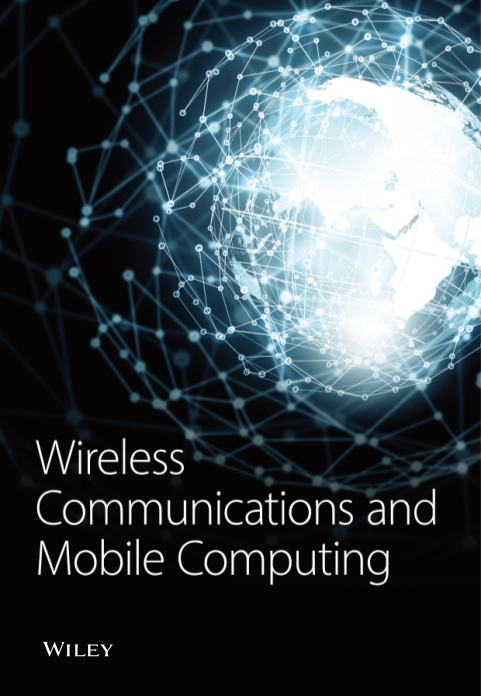[Retracted] Internet of Things-Based Patient Cradle System with an Android App for Baby Monitoring with Machine Learning
Abstract
It is becoming more popular because of the widespread availability of high-speed Internet and the widespread use of mobile phones, both of which are contributing to its rise in popularity. One such significant issue is the use of mobile phones by working parents to keep an eye on the behaviour of their children while they are babysitting for others, which is a significant concern. This study introduces the notion of a smart cradle, which enables for this kind of video monitoring to be carried out on an infant. An infant’s scream triggers the automated swinging of this cradle, which begins when the sensor detects it. In addition, if the baby’s cry persists for an extended period of time, the gadget triggers a buzzer and sends a text message to the phone, signalling that the cradle is no longer capable of handling the infant and that the baby needs human assistance if the cradle’s mattress is wet. This cradle is equipped with an automatic spinning toy for the baby’s entertainment, which reduces the likelihood of a newborn crying throughout the day. A notable rise in the number of working mothers has been seen in recent years. Consequently, the vast majority of parents place their children in the care of their grandparents or in the care of child-minding companies. In addition, we developed a new algorithm for our system, which is critical in delivering better newborn care when parents are not there to assist. Due to the fact that parents are unable to continuously monitor their children’s condition in ordinary or atypical situations while they are at work, this is the case. Node is the fundamental building unit of a microcontroller. Over the course of a single day, the controller board will collect data from the sensors and transmit it to the Adafruit MQTT server over Wi-Fi to be processed. In addition to monitoring the baby’s vital signs, sensors are also used to detect environmental conditions such as the temperature, humidity, and amount of crying in the surroundings. Using the NX Siemens software, a prototype for the cradle was created. Red meranti wood was utilized in its construction. Whenever the baby begins to scream, the system design automatically swings the infant cradle, which is powered by a motor that is built into the system. In addition, parents may use an external web camera to keep checks on the health of their children when they are away from home. Every aspect of this network has been tested to guarantee that it functions effectively and safely at all times.
1. Introduction
Telemedicine is a multidisciplinary concept that encompasses various fields such as physiology, biomedical instrumentation, and telecommunications to provide medical assistance from a remote location. Telemedicine is an effective solution for many constraints of healthcare assistance such as shortage of doctors, geographical distance to cover [1], and large population. Despite the numerous advantages, the practice of telemedicine is not up to the mark as the equipment to practice telemedicine is relatively expensive at this moment. A typical telephone conversation and video conferencing is not an effective way of telemedicine as the doctor might not know the physiological parameters of the subject. For this, a holistic system with different sensors is required to make the doctor feel the virtual presence of the patient with all the possible physiological parameters. With the latest evolutions in embedded systems and the Internet of Things, a low-cost, portable telemedicine system is developed. The sensors are operated with power-efficient circuitry without affecting precision and repeatability. The signals of the sensors are processed and plotted with advanced programming language algorithms [2]. The system seamlessly monitors the parameters and visualizes the measurements via the created graphical user experience. As the designed system is very much user-friendly, it can be operated with little training, unlike most other medical equipment. The designed system is capable of measuring multiple physiological parameters with good stability. The parameters include saturation percentage of oxygen in the blood, skin temperature, heart rate, pulse rate electrocardiogram, and pulse transit time based on noninvasive blood pressure.
- (1)
When the sound of a newborn cry is recognized, the automatic swaying of the cradle starts
- (2)
If the infant does not cease screaming after a certain period of time, the device sounds an alarm and sends a notice to the parent’s smartphone
- (3)
The alarm will ring and an alert will be issued if the mattress is soaked
Keeping a healthy atmosphere around the infant is important, and the second alarm is important for providing care as needed when the baby is in need. This information may be transferred from a cloud server to an Android smartphone with the use of an application [4]. Because of the Internet, a parent may learn about their child’s status at any time and from any place, which is a significant advantage of such an alert.
Nowadays, people are more likely to utilize an Android smartphone than they were before. As a consequence, Android technology is used in the development of the system.
Sensors are devices that sense physical quantities and generate equivalent electrical signals. Sensors have become an integral part of human life as they are omnipresent, especially in the modern era where almost everybody possesses an electronic gadget [5]. The sensors collect data of different kinds, which are usually found at the input of the embedded systems. There have been a vast number of sensors that can be categorized into various types depending on the form of output they deliver, the elements involved in making the sensors, their principles, measure, and techniques [6]. The actuators are the transducers that convert electrical signal to mechanical signal that moves and controls the systems connected to them [7]. For instance, in an electronic sphygmomanometer, the air cuff is filled and emptied by the actuator after receiving the electronic signal from the microcontroller in the system [8]. The IoT-connected actuators can be remotely used for performing operations in numerous applications such as robotics to move the limbs using stepper motors and home appliances for switching the water pumps on and off [9].
Figure 1 represents the basic block. In embedded systems, not all transducers can directly exchange digital information as some transducers do not have data converters. The analog data from the sensors can be interfaced to the inbuilt analog to digital data converter of the processing unit [10]. If the distance between the sensor and controller is high, it is better to digitize immediately after acquiring the data using external ADC for better noise immunity [11]. In parallel, some actuators do not have inbuilt data converters and can deal with only analog signals. As the microcontrollers provide the digital output, digital to analog signal converters are required to interface the actuators [12]. Even if the microcontrollers have inbuilt memory, it is very limited; hence, to improve the system’s performance, external memory devices are interfaced with microcontrollers. An embedded system often requires an operating system for which a bootable read-only memory (ROM) is required for performing high-end applications. The read-only memory devices such as compact disk-ROMs, hard disk drives, pen drives, and solid-state drives with the operating system boot the embedded devices and store the information nonvolatilely [13]. For faster operations, the random access memory (RAM) can also be extended by connecting the external RAM modules. The dynamic synchronous RAM modules are available in different packages such as single-inline, dual-inline, and small-outline dual-inline.
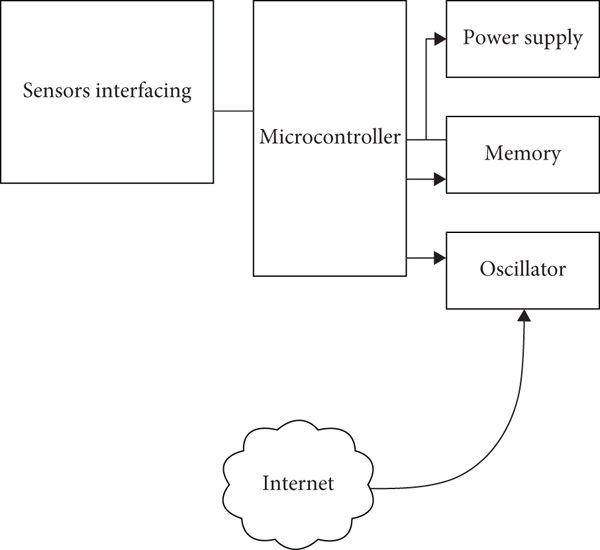
The present work contributes to the state-of-the-art technology with a cost-effective system for telemedicine applications. The need for repeated calibration for the photoplethysmogram-based oxygen saturation sensor is eliminated by programming the current operating levels and tracking the temperature variation of the sensor [14]. The synchronous and simultaneous acquisition of the photoplethysmogram and electrocardiogram signals [15] is performed for accurately measuring the pulse transit time (PTT) that is further calibrated for blood pressure monitoring. The blood pressure measurement is performed without a cuff wrapped around an arm. The system is provided with a quality graphical user experience for displaying the medical signals and parameters [16]. The portable system is interfaced with a camera with which the medical practitioner can observe the condition of the patient from remote locations.
2. Related Work
The current smart health monitoring system is based on an Android phone, and it receives raw data from wearable sensors before transferring it to a microcontroller for further analysis. Afterward, the output is sent to an Android smartphone via Bluetooth. In some current health monitoring systems, a GSM module is utilized to send an SMS alert to a mobile phone, which is then acted upon.
Kumar et al. [17] were the first to construct a rocking cradle that was both safe and automated. The oscillating action of the spring-loaded motor was utilized to rock the cradle, giving the impression that it was being rocked by the mother. Both the standard crib and the electric crib are linked to each other. Controlling the rocking is accomplished with the use of an electrical gadget [18]. When the microphone detects the baby’s cries, it automatically starts rocking the infant for a certain length of time, which is controlled by the timer on the device. Later on, a gadget for detecting the sound of a crying infant is created and tested. Whereas an amplifier amplifies the sound signal, the pulse generator circuit is responsible for generating the pulse signal in real time [19]. This pulse signal is delivered to a signal processor for further processing. The output of the recognition circuit is the detection of screams from the infant. Presented below is an autonomous baby rocker that incorporates a noise sensor. A preamplifier amplifies the incoming sound signal and sends it to an Arduino atmega328A microcontroller, which in turn controls the rocking motion of a newborn. A few brightly colored LED lights are used to keep the newborn entertained while the mother is rocking her [20]. V. Kumar et al. offer a system for controlling the amount of swaying crib experiences based on sensor data. A total of three pressure sensors were used to assess the health of an infant during the 2017 Third International Conference on Computing, Communication, Control, and Automation. One sensor was placed in the center of the bassinet, and the other two were placed on the left and right of the bassinet bottom (ICCUBEA) [21].
Joseph et al. discussed the medical facilities in India and stated that the urban and rural healthcare system impacts the medical system in the country. Around 700 million people in India are unable to have quality medical facilities as they live in rural areas in India [22]. The medical specialists of around 80% can serve their duties to only 20% of the total population in India. The author proposed a possibility to extend the access of doctors available in urban to the rural areas virtually to improve the medical 28 standards. Video conferencing is one of the best options for the e-home visit of medical experts, and it further provides international teleconsultation [23]. In the telemedicine system, the doctor and the patient meet each other virtually, and the process involves monitoring the patient by the doctor from different locations. This further saves the traveling time from a rural area to an urban area for either a doctor or a patient. The telemedicine system includes the acquisition of images, processing, and display of the required information [24]. The virtual visiting of a medical expert to the intensive care unit (ICU) plays a crucial role in providing better medical care from remote locations [25]. A telemedical system was designed by Toole and Boylan that can provide mobile telemedicine facilities to patients living at remote locations. Providing adequate medical care facilities is a challenging issue in highly demographic and industrialized countries. The patients from remote locations in these countries cannot avail good medical care in time, leading to death [26]. Hence, a system must be designed and available every time to check the health parameters of a person living in remote locations and send the information to the required place to take the necessary steps. In this study, a designed system consists of some sensors to measure the health parameters, and it is set in a distributed network system to support the medical care system in a remote area [27]. A teleservice center to analyze data is integrated with the system to assist the patients in a critical position from a remote location. As the patients need not travel from one place to another for the medical facilities, the designed system helps decrease medical cost and traveling time [28]. The notable growth of potentiality in the telecommunication and data acquisition system gives advanced solutions in assisting medical care units in remote areas. The system assists in treating several diseases as the multiple sensors are integrated and offer communication for remote supervision. The system mainly consists of ECG, pulse oximeter, weighing scale, and blood pressure monitor [29]. The measured information from the sensors is executed by the data acquisition unit (DAU) and a smartphone in this study [30]. Holekamp et al. designed an Android-based telemedicine system to improve the healthcare units in remote places where the doctors and the medical facilities cannot reach in time [31]. The system used a health record on a cloud system to store the data to keep a record of a patient. The information related to the patient’s health is sent to the doctor for further treatment process. The proposed system mainly concentrates on the provider-to-provider system to serve the remote and rural patients through the health providers. The system connects the rural health workers to the remote doctors so as to start the primary medical care at an early stage [32]. The system consists of open source tools, such as Android client, to handle the collection of the data related to patients. The SQL database system was used to manage the data into the database for further reference of a patient. Dameshek and Loman [33] describe in the study about the crucial role of telemedicine in medical care. The telemedicine system in the pediatric care units can support improving medical care and convenience by expanding the reach of a doctor to patients. Earlier, telemedicine was a service only up to remote areas where there are fewer possibilities of an adequate care system, but now it has become the first choice for most hospitals due to the evolution of technologies in medical care. The preponderance part of United States healthcare systems prefers remote health care, and they are working on expanding the network of care to highly populated areas [34]. The telemedicine system provides much superiority to public health, such as giving access to care units by spending less time. A patient can choose a medical check-up from their home using their comfort in a direct-to-consumer system [35]. In this system, a patient can connect using video calls with the physician that enhances the interaction between doctor and patients. The quality of the medical care and safety of the patients is the main challenge in the telemedicine system [36]. The crucial role of telecardiology in telemedicine was described. The cardiologist living far away from a patient can be easily consulted by the telecoronary care unit. The development of different technologies and IoT-based applications plays a crucial role in transmitting health-related information from remote areas to concerned medical units. However, if the teleintensive care unit (tele-ICU) models are appropriately accomplished, then the chances of complication and rate of mortality can be controlled. In telemedicine, the tele-ICU system is helpful in transmitting the patients’ health information such as blood pressure, respiration, and body temperature to the central monitoring places in real time [37]. This further helps the doctors at the central monitoring place to provide support for the physicians at the patient’s side continuously. In telemedicine technology, telecardiology is one of the essential areas which transmit the tracked values of ECG to a cardiologist for further 30 treatments. The transmission of the recorded ECG information can be shared via smartphone or tablet, even from home [35]. Echocardiography is a vital tool for a cardiologist that helps to investigate the function of the heart. The echo telemedicine system is used to send the information related to a patient’s heart to the concerned medical units. In the teleechocardiography system, the significant role is played by an operator who needs to operate the ultrasonography image system properly. Dinesh [38] explains the importance of telemedicine in the medical system and describes how telemedicine can fill the gap between health services available in an urban area and rural area. There is a need for a practitioner to fathom the information of the complete process in the telemedicine system, such as connecting a doctor to a patient in the required time [37]. In the study, the author finds different ways to make telemedicine a successful process in India effectively. An unruffled interaction between doctors and patients must happen in the telemedicine system. There are three main factors which play a very crucial role in the successful process of the telemedicine system, and these are good connectivity of Internet for better communication, good tutoring of a doctor, and molding of a patient from callow character to an expert in technology so that the patient can operate the advanced technology machines when required [39]. In the process of a telemedicine system, the processing of data is also very important. The data from recordings of video teleconsultations, and conversations of the patients and doctors, must be processed well [40]. A study by Renner et al. found several factors that play a significant role in implementing telemedicine services. The authors studied telemedicine, which helped to find the supporting factors to stabilize effective telemedicine services. The authors did in-depth research work for six years on three telemedicine services from several years in Italy. The screening process of the telemedicine services in Italy was performed between 2008 and 2010 by selecting a database generated by the Italian Ministry of Health. It helps to find the different cases under the telemedicine services and the factors which can be taken care of for making effective telemedicine services [41]. The studies found that organizational stability and financial condition for telemedicine services play a crucial role. The organizational stability can be improved by a good knowledge of medicine and taking enough required care on patients that further enriches the professional acceptance. By using advanced technologies, patients can get their needs, such as the availability of a nurse every time, which also improves organizational stability [42]. The authors found that financial stability can be enhanced by applying several strategies which involve hospital management and policymakers [43].
The goal of this study was to establish normative data for oxygen saturation (SpO2), heart rate (HR), abdominal (Ta) and peripheral temperatures (Tf), and noninvasive blood pressure (NIBP) in newborns from birth to the first 12 hours of life through continuous electronic monitoring and simultaneous clinical assessment at The Children’s Hospital and to compare the transitional adaptability of infants born in TCHs, PHCs, and homes, as well as between them and previously published data from the literature.
It was expected that neonates born in tertiary hospitals, primary health centers, and rural residences will have different postnatal adaption (cardiopulmonary and thermal) than those born in other settings.
Secondary hypotheses include the following: (1) infants born in a primary health center or at home have worse adaptability than those born at a tertiary hospital. (2) Performing a close clinical examination of the newborns is akin to using electronic monitoring to detect indicators of poor transitioning.
3. Proposed Methodology
- (i)
Cradle: a cradle is a bed for a newborn that is in some manner powered by a motor
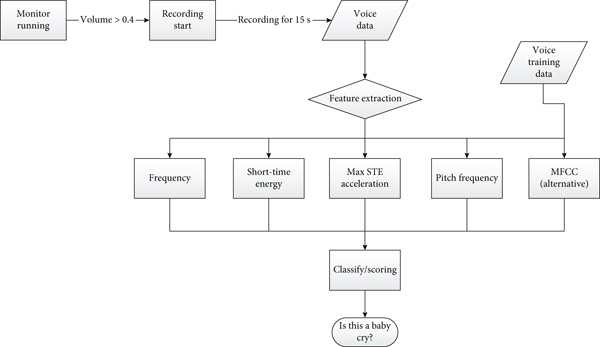
- (ii)
Camera: for video monitoring, a camera is placed in close proximity to the cradle. It is always snapping images. It is used to determine whether or not a baby is on the way
Parents may keep track on their children’s activities using an app and the Internet.
Noninvasive blood pressure monitoring using an automated oscillometric approach is commonly utilized in the care of infants and children. A cuff pressure is placed around an extremity, and then, the pressure is withdrawn from the area of application. Pulsating arteries are caused by the reduction of the cuff pressure until it is lower than the systolic pressure of the blood vessel [44]. These pulsations are relayed back to the cuff, and the oscillations caused by these pulsations are detected by the transducer and stored. It is the pressure at which the cuff oscillation starts to rise when the cuff is deflated that determines the systolic pressure. The mean pressure is chosen as the lowest cuff pressure at which oscillations are at their most severe, and the diastolic pressure is chosen as the pressure at which the amplitude of cuff oscillations ceases to decrease, respectively [45].
It has been shown that there is a good connection between mean blood pressure measures and direct intra-arterial blood pressure monitoring. The Tempa-Kuff brand cuff is latex-free and is compatible with any NIBP monitoring equipment that uses single lumen cuffs, including the Tempa-Kuff.
(Single lumen refers to a single tube that extends from the cuff.) We discovered that this was an appropriate method for measuring the NIBP.
Figure 2 gives the overall processing unit. The revolving toy is designed to keep the infant occupied while lowering the chances of crying. A baby generally screams when he or she wakes up after a slumber. A spinning toy can reduce the baby’s crying by entertaining him [43]. When a baby cry is detected, the toy starts spinning and keeps spinning for the following 5 minutes. The toy’s spinning may be controlled by the user as well.
It was decided to use the multichannel monitor Planet 55, which was turned on before to the birth and maintained ready by attaching two temperature probes to it, as well as the blood pressure monitoring cable with the neonatal cuff, and the patient cable with the SpO2 probe to it.
All of the babies were placed on a tray covered with a warm towel as they arrived. The time of birth was recorded after the infant was completely delivered, as well as the time it took to clamp the cord.
The baby’s right hand was dried straight away, and the SpO2 sensor was inserted as soon as possible. The patient wire was then attached to the device. The oxygen saturations were monitored using reusable probes from the Nellcor DURA-Y multisite oxygen sensor model D-YS, manufactured by Nellcor. The temperature probes were connected to the infant after it had been completely dried.
On the right hypochondrium, just above the umbilicus, a central skin temperature probe was implanted, and on the sole of the foot, above the heel, a peripheral skin temperature probe was connected to the sole of the foot and fixed in place using micropore tape, for skin temperature monitoring.
3.1. Block Diagram
- (i)
Noise sensor: a noise sensor is a device that detects and measures sound loudness. A microphone detects the sound of a crying infant in the bassinet and transforms it to an electrical signal
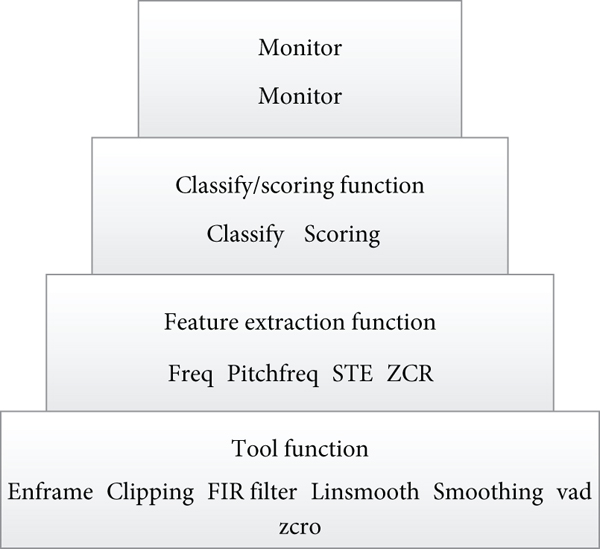
The feature set contains amplitude, spectral, connectivity, and burst annotation features. Amplitude features include range-EEG (D. O’ Reilly et al., 2012; see references), a clearly defined alternative to amplitude-integrated EEG (aEEG). All features are generated for four different frequency bands (typically 0.5–4, 4–7, 7–13, and 13–30 Hz), with some exceptions. Table 1 describes the features in more detail:
| Feature name | Description | FB |
|---|---|---|
| spectral_power | Spectral power: absolute | Yes |
| spectral_relative_power | Spectral power: relative (normalised to total spectral power) | Yes |
| spectral_flatness | Spectral entropy: Wiener (measure of spectral flatness) | Yes |
| spectral_entropy | Spectral entropy: Shannon | Yes |
| spectral_diff | Difference between consecutive short-time spectral estimates | Yes |
| spectral_edge_frequency | Cut-off frequency (fc): 95% of spectral power contained between 0.5 and fc Hz | No |
| FD | Fractal dimension | Yes |
| amplitude_total_power | Time-domain signal: total power | Yes |
| amplitude_SD | Time-domain signal: standard deviation | Yes |
| amplitude_skew | Time-domain signal: skewness (absolute value) | Yes |
| amplitude_kurtosis | Time-domain signal: kurtosis | Yes |
| amplitude_env_mean | Envelope: mean value | Yes |
| amplitude_env_SD | Envelope: standard deviation (SD) | Yes |
| connectivity_BSI | brain symmetry index (see Van Putten 2007) | Yes |
| connectivity_corr | Correlation (Spearman) between envelopes of hemisphere-paired channels | Yes |
| connectivity_coh_mean | Coherence: mean value | Yes |
| connectivity_coh_max | Coherence: maximum value | Yes |
| connectivity_coh_freqmax | Coherence: frequency of maximum value | Yes |
| rEEG_mean | Range EEG: mean | Yes |
| rEEG_median | Range EEG: median | Yes |
| rEEG_lower_margin | Range EEG: lower margin (5th percentile) | Yes |
| rEEG_upper_margin | Range EEG: upper margin (95th percentile) | Yes |
| rEEG_width | Range EEG: upper margin-lower margin | Yes |
| rEEG_SD | Range EEG: standard deviation | Yes |
| rEEG_CV | Range EEG: coefficient of variation | Yes |
| rEEG_asymmetry | Range EEG: measure of skew about median | Yes |
| IBI_length_max | Burst annotation: maximum (95th percentile) interburst interval | No |
| IBI_length_median | Burst annotation: median interburst interval | No |
| IBI_burst_prc | Burst annotation: burst percentage | No |
| IBI_burst_number | Burst annotation: number of bursts | No |
- FB: features generated for each frequency band (FB).
4. Results
In WSN, the source and destination are connected through a wireless communication channel. The source sends the data to the destination in terms of fixed-length packets. Round-trip time (RTT) or round-trip delay (RTD) in any network is defined as the amount of time it takes for a data packet to be sent plus the amount of time it takes for the reply of that data packet to be received. The analytical model for the distribution of end-to-end delay in WSNs is as follows:
Here TMS represents the time required to send the data packets from mobile to server, TSM is the time required to return the reply from server to mobile, and TPD is the processing delay. The processing delay includes the time required for data collection and decoding operations in the sensor like analog to digital conversion of data for further processing, the time required for data transfer from sensor to mobile, and the diagnosing time in the server.
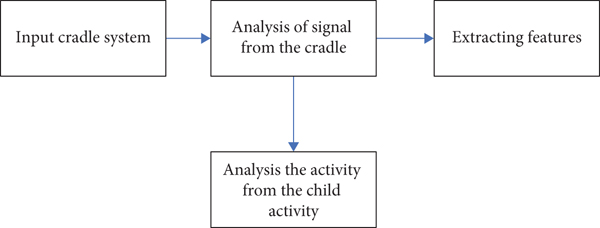
TD represents transmission delay, N represents a number of bits in a packet, and R represents the rate of transmission.
Then, TPD value for 20 to 40 transmissions is taken as 40 ms, 31 ms for 40 to 60 transmissions, 43 ms for 60 to 80 transmissions, and 39 ms for 80 to 100 transmissions. Now, the RTT value for these transmissions is also calculated, and these analytical results are compared with the experimental values, and the result in Table 2 gives the experimental analysis.
| Data transmissions (iterations) | Average RTT values (ms) | |
|---|---|---|
| Experimental | Analytical | |
| 1-20 | 441.1 | 443.6 |
| 20-40 | 447.1 | 449.6 |
| 40-60 | 437.55 | 440.6 |
| 60-80 | 450.8 | 452.6 |
| 80-100 | 446.1 | 448.6 |
The graph in Figure 5 shows that the values in the analytical method closely match the experimental values.
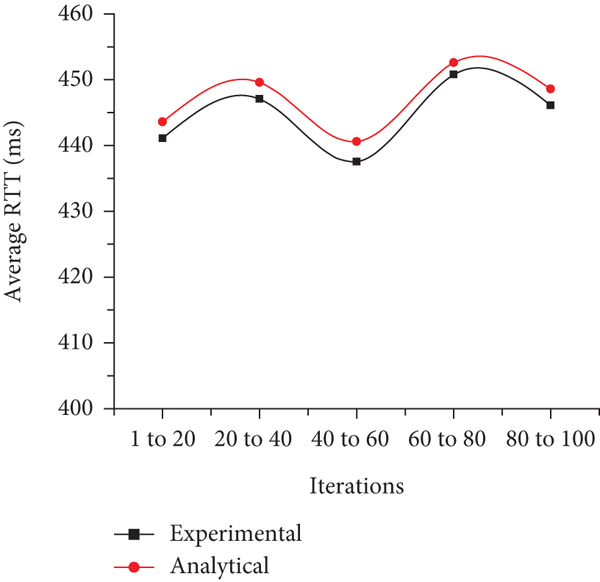
4.1. Performance Analysis
| Time (s) | Data sent (bytes) | Data received (bytes) | Data delivery ratio (%) |
|---|---|---|---|
| 1 | 118 | 116 | 98.3 |
| 5 | 493 | 486 | 98.5 |
| 10 | 802 | 789 | 98.4 |
| 15 | 1236 | 1220 | 98.7 |
| 20 | 1613 | 1575 | 97.6 |
| 25 | 1988 | 1960 | 98.5 |
| 30 | 2360 | 2320 | 98.3 |
| 35 | 2738 | 2701 | 98.6 |
| 40 | 3119 | 3050 | 97.7 |
| 45 | 3502 | 3425 | 97.8 |
| 50 | 3881 | 3806 | 98 |
The graph in Figure 6 shows that a high percentage of the data delivery ratio is reported in the system persistently. Hence, it is concluded that the proposed framework achieves a high DDR (above 97.5%) constantly at all times.
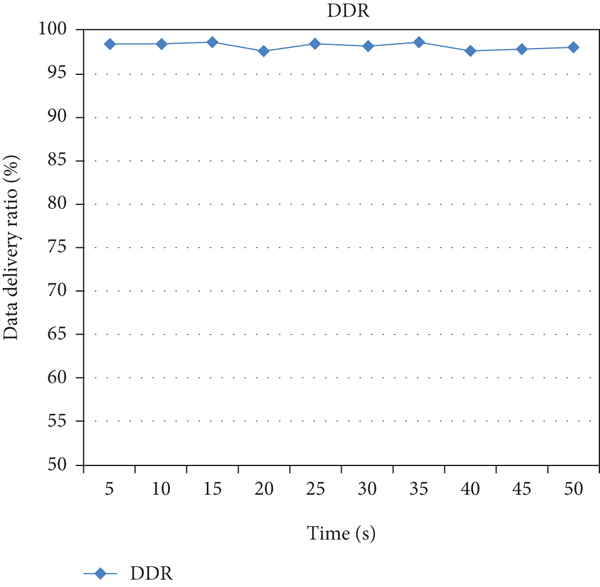
4.1.1. Throughput
Based on the values in Table 4, the throughput is calculated for different periods, and the resulting graph is shown in Figure 7.
| Time (s) | Data received (bytes) | Throughput |
|---|---|---|
| 10 | 789 | 78.9 |
| 20 | 1575 | 78.75 |
| 30 | 2320 | 77.33 |
| 40 | 3050 | 76.25 |
| 50 | 3806 | 76.12 |
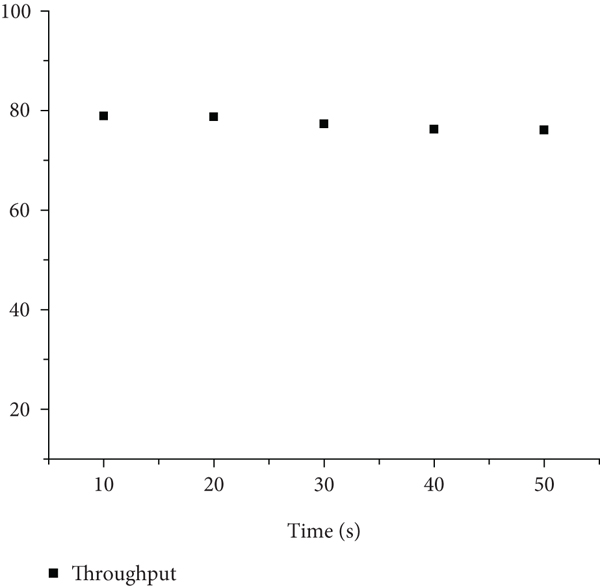
The graph shows that constant throughput values are achieved in the system during different periods.
- (i)
Babies who are asleep in a cradle without a toy or an autoswing are considered
- (ii)
Babies sleep in cradles that have a rotating toy, an autoswing, and monitoring devices
It has been observed that the infant pays greater attention as a result of the proposed cradle system design. It also ensures the infant’s safety while in the babysitter’s care.
Block A and block B of the system are the AMD processor and the AVR controllers, respectively, and they are interconnected using universal serial bus 2.0. Block C of the schematic diagram is the ECG and PPG sensor MAX86150 that is interfaced to block B by employing the two-wire serial communication protocol. The reflective type SpO2 sensor MAX30102 is block D connected to block B using clock and data lines. Block E is the temperature sensor MAX30205 connected to block B with serial clock and serial data. The HDMI display is block F of the system connected to block A to visualize the output on the local system. Block G, the eMMC that runs the OS and stores the information locally, is connected to block A. An SDRAM is block H of the designed system which is connected to block A. A digital camera, block I, is interfaced to block A to record and stream the patient’s videographic information. A tiny wireless fidelity module is the block J of the designed system interfaced to block A through a USB connection.
5. Conclusion
A reliable and efficient patient monitoring system that facilitates the continuous collection of body parameters is the goal of the “Secure Automated Patient Monitoring System” project. There were many difficulties related with wireless sensor-based patient monitoring systems that were addressed in this thesis. The BSN is created with the assistance of a temperature sensor. As a local database, the Android smartphone removes the need for a computer and is capable of outside surveillance. A modified version of the CP-ABE algorithm is used to provide access control and secure transmission. Patient’s present position is monitored using latitude and longitude data, which are then transmitted to the hospital’s central server. The algorithm’s functioning is tested using a prototype that incorporates a temperature sensor, and the actual patient monitoring is carried out with the assistance of a real-time implementation of the algorithm. It is quite beneficial in determining how well the patient monitoring system is really performing. Baby care is a difficult topic to master everywhere in the globe. It is a significant duty, given that they are the ones who will define our collective destiny in the future. Despite the fact that the optimum position for a newborn is on a mother’s lap, this strategy was devised to meet the needs of the modern world while still emphasizing the necessity of infant care. This system is low-cost and simple to operate, making it an excellent choice for parents who are short on time. Almost all regularly used Android smartphones, including the great majority of them, can be used to watch video.
Conflicts of Interest
Authors declare that there are no conflicts of interest.
Open Research
Data Availability
The data that support the findings of this study are available on request from the corresponding author.



